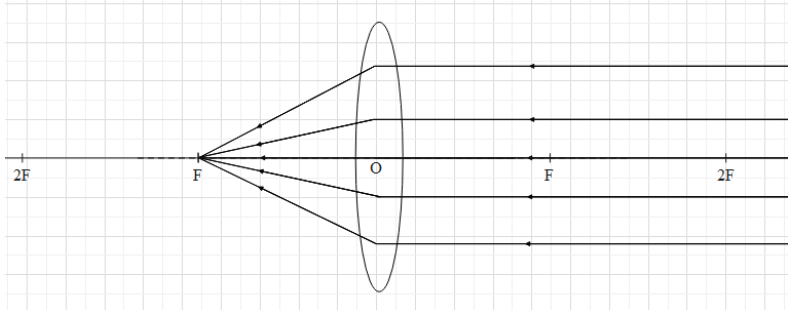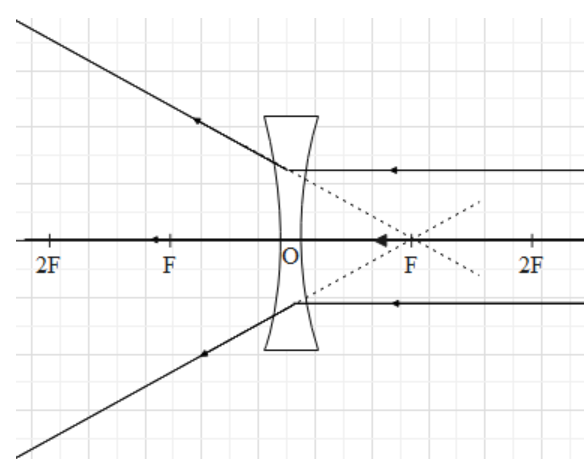
The type of lens present in human eye is
A. convex lens
B. Concave lens
C. Plano convex lens
D. Plano concave lens
Answer
432k+ views
Hint: A convex lens and a plano convex lens are converging lenses that converge the light rays passing through them at a single point. A concave lens and a plano concave lens are diverging lenses that diverge the light rays passing through them in all directions.
Complete step by step answer:
The lens present in a human eye is a convex lens.
We humans can see different colours or objects. We can see these things because the light from the visible rage of the electromagnetic spectrum, emitted by the objects enters our eyes, passing through a lens and then falls on the retina inside our eyes. Retina is a light sensitive membrane. The image of the object is found on the retina and this is sent to the brain through nerve impulses. Then the brain interprets the send data, which gives a certain colour to the object in front of us.
However, just entering the light into our eyes will not help us to see. The objects that are visible to us must also be clear. Otherwise, we will not be able to identify the objects. The clarity of the objects that we see depends on the intensity of the image formed on the retina. In other words, we can focus on the objects in front of when the intensity of the image formed on the retina is maximum.
If all the light rays entering our eyes, concentrate at a single point the intensity of the image will be maximum. We know that lenses refract the light rays passing through them. Different lenses refract the light rays differently. Some lenses converge the light rays whereas some diverge the light rays.
The light entering our eyes must be converged at a single point. Therefore, the lens in our eyes must be a converging lens and a convex lens is a converging lens. Therefore, the lens present in a human eye is a convex lens.
To understand better about the image formation by a convex look at the figure given below.

Here, the object is at infinity. Therefore, the rays of light from this object are parallel to each other. When the rays of light are parallel to the optical axis, after refraction the rays intersect at the focus (F) of the lens that is on the other side of the lens (as shown).
Hence, the correct option is A.
Note: A plano convex lens is a type of lens that has one flat surface and one convex surface. Like a convex lens, a plano convex lens is also a converging lens. However, the naturally existing lens in our eye is a convex lens.
A concave lens is a diverging lens that diverges the parallel light rays passing through it (as shown in the figure below).

A plano concave lens has one flat surface and other as a concave surface. It has the properties of a normal concave lens. therefore, it is also a diverging lens.
Complete step by step answer:
The lens present in a human eye is a convex lens.
We humans can see different colours or objects. We can see these things because the light from the visible rage of the electromagnetic spectrum, emitted by the objects enters our eyes, passing through a lens and then falls on the retina inside our eyes. Retina is a light sensitive membrane. The image of the object is found on the retina and this is sent to the brain through nerve impulses. Then the brain interprets the send data, which gives a certain colour to the object in front of us.
However, just entering the light into our eyes will not help us to see. The objects that are visible to us must also be clear. Otherwise, we will not be able to identify the objects. The clarity of the objects that we see depends on the intensity of the image formed on the retina. In other words, we can focus on the objects in front of when the intensity of the image formed on the retina is maximum.
If all the light rays entering our eyes, concentrate at a single point the intensity of the image will be maximum. We know that lenses refract the light rays passing through them. Different lenses refract the light rays differently. Some lenses converge the light rays whereas some diverge the light rays.
The light entering our eyes must be converged at a single point. Therefore, the lens in our eyes must be a converging lens and a convex lens is a converging lens. Therefore, the lens present in a human eye is a convex lens.
To understand better about the image formation by a convex look at the figure given below.

Here, the object is at infinity. Therefore, the rays of light from this object are parallel to each other. When the rays of light are parallel to the optical axis, after refraction the rays intersect at the focus (F) of the lens that is on the other side of the lens (as shown).
Hence, the correct option is A.
Note: A plano convex lens is a type of lens that has one flat surface and one convex surface. Like a convex lens, a plano convex lens is also a converging lens. However, the naturally existing lens in our eye is a convex lens.
A concave lens is a diverging lens that diverges the parallel light rays passing through it (as shown in the figure below).

A plano concave lens has one flat surface and other as a concave surface. It has the properties of a normal concave lens. therefore, it is also a diverging lens.
Recently Updated Pages
Master Class 12 Economics: Engaging Questions & Answers for Success

Master Class 12 Maths: Engaging Questions & Answers for Success

Master Class 12 Biology: Engaging Questions & Answers for Success

Master Class 12 Physics: Engaging Questions & Answers for Success

Master Class 12 Business Studies: Engaging Questions & Answers for Success

Master Class 12 English: Engaging Questions & Answers for Success

Trending doubts
The probability that a leap year will have only 52 class 12 maths CBSE

Describe the poetic devices used in the poem Aunt Jennifers class 12 english CBSE

And such too is the grandeur of the dooms We have imagined class 12 english CBSE

What does the god that failed refer to class 12 english CBSE

Which country did Danny Casey play for class 12 english CBSE

Draw a labelled sketch of the human eye class 12 physics CBSE




